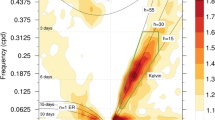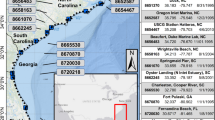Abstract
The Salton Sea, the largest `man-made' water body wholly within California, was formed in 1904 as the result of a levee failure along the Colorado River. Initially, flow into the Salton 'Sink' created a fresh water lake about 24 m deep with a water surface about 85 m below the level of the ocean. Salinity of the water body, at first roughly the same as the river, rose rapidly due to solution of previously accumulated residual salt, then following levee repair, adjusted to the combined influence of agricultural drainage accretions and evaporative losses. Water levels adjusted accordingly, at first declining then rising slowly until the mid 1930s when a level about 75 m below ocean level was reached. Thereafter, both water levels and salinity gradually rose, so that at present the surface elevation of the Sea stands near −69.5 m and salinity is approaching 45 g l−1, about 30% above ocean salinity. The Salton Sea Authority is seeking practical methods for reducing water levels and controlling salinity within ranges that will protect beneficial uses of the Sea, its adjacent lands, and its indigenous ecosystems, both aquatic and avian. Proposed solutions include various physical changes in the bathymetry and configuration of the Sea, especially its southern basin. Because circulation in the Sea is driven primarily by wind stresses imposed on the water surface, and circulation changes are likely to affect the Sea's quality and ecology, a methodology for quantifying the effects of specific alternatives is required. For this purpose a mathematical model for simulation of the hydrodynamic behavior of the Sea has been developed, calibrated to data gathered by a field investigation conducted in 1997, and applied to alternative schemes that will isolate sections of the southern basin, thus changing the natural wind induced circulation in areas that are ecologically sensitive. The Salton Sea Hydrodynamic/Water Quality Model is constructed using the finite element method to represent the bathymetry of the Sea as it currently exists, or may subsequently be modified, in a three-dimensional grid. Given certain boundary conditions, for example wind stresses imposed on the surface, the model solves the three dimensional equations of motion and continuity, the advection–dispersion equation, and an equation of state dependent upon temperature and salinity, to obtain temporal and spatial descriptions of velocities and temperatures over a specified period of time. Using data derived from 1997 field measurements of velocities using acoustic Doppler current profilers and temperature sensors, the model was calibrated to reproduce mathematically the historic experience of field observation. The model successfully replicated principal features of the Sea's behavior, especially the persistence of a counterclockwise gyre in the southern basin and seasonal stratification. Once calibrated, the model was applied to evaluate the possible effects of changing water surface elevations in the Sea and altering its configuration to isolate sections for evaporative concentration of salts. These effects, evident in changes in velocity, were quantified with regard to their possible impacts on the aquatic habitat and the health of the Salton Sea ecology. A comparative evaluation of alternatives is presented.
Similar content being viewed by others
References
Barko, J. W., D. Gunnison, S. R. Carpenter, 1991. Sediment interactions with submersed macrophyte growth and community dynamics. Aquat. Bot. 41: 41-65.
Blackburn, T.H., 1987. Microbial food webs in sediments. In Sligh, M. A. (ed.), Microbes in the Sea. Ellis Horwood, Chichester: 39-58.
Boudouresque, C. F., A. Meinesz, M. Verlaque & M. Knoeppfler-Peguy, 1992. The expansion of the tropical alga Caulerpa taxifolia (Chlorophyta) in the Mediterranean. Cryptogamie, Algol 13: 144-145.
Boudouresque, C.F., 1997. Population dynamics of Caulerpa taxifolia in the Mediterranean, including the mechanisms of interspecific competition. Séminaire international 'Dynamique d'espèces marines invasives: application à l'expansion de Caulerpa taxifolia en Méditerranée', Lavoisier publ., Paris, Fr.: 145-162.
Carlton, J. T., 1989. Man's role in changing the face of the ocean: biological invasions and implications for conservation of nearshore environments. Conserv. Biol. 3: 265-273.
Ceccherelli, G, 1997. Aspetti ecologici di Caulerpa taxifolia (Vahl) C. Agardh (Chlorophyta, Caulerpales): interazioni biotiche e fattori fisici e chimici. Ph.D. Thesis, Dipartimento dell'Uomo e dell'Ambiente, Università di Pisa: 138 pp.
Ceccherelli, G. & F. Cinelli, 1997. Short-term effects of nutrient enrichment of the sediment and interactions between the seagrass Cymodocea nodosa and the introduced green alga Caulerpa taxifolia in the Mediterranean bay. J. Exp. mar. Biol. Ecol. 217: 165-177.
Ceccherelli, G. & F. Cinelli, 1998. Habitat effect on spatio-temporal variability of size and density of the introduced alga Caulerpa taxifolia. Mar. Ecol. Prog. Ser. 163: 289-294.
Ceccherelli, G. & Cinelli, F. 1999a. A pilot study of nutrient enriched sediments in a Cymodocea nodosa bed invaded by the introduced alga Caulerpa taxifolia. Bot. Mar. 42: 409-417.
Ceccherelli, G. & F. Cinelli, 1999b. Effects of Posdonia oceanica canopy on Caulerpa taxifolia size in a north-western Mediterranean bay. J. exp. mar. Biol. Ecol. 240: 19-36.
Ceccherelli, G., L. Piazzi & F. Cinelli, 1999. Response of the nonindigenous Caulerpa racemosa (Forsskål) J. Agardh to the native seagrass Posidonia oceanica (L.) Delile: effect of density of shoots and orientation of edges of meadows. J. exp. mar. Biol. Ecol. 243: 227-240.
Delgado, O., C. Rodríguez-Prieto, E. Gacia, & Ballesteros, E. 1996. Lack of severe nutrient limitation in Caulerpa taxifolia (Vahl) C. Agardh, an introduced seaweed spreading over oligotrophic Northwestern Mediterranean. Bot. Mar. 39: 61-67.
Den Hartog, C., 1997. Is Sargassum muticum a threat to eelgrass beds? Aquat. Bot. 58: 37-41.
Druehl, L., 1973. Marine transplantation. Science 179: 1-12.
Grasshoff, K., 1976. Methods of seawater analysis. Verlag Chemie, Weinheim.
Hemminga, M.A., 1998. The root/rhizome system of seagrass: an asset and a burden. J. Sea. Res. 39: 183-196.
Hemminga, M. A., P. G. Harrison & P. van Lent, 1991. The balance of nutrient losses and gains in seagrass meadows. Mar. Ecol. Prog. Ser. 71: 85-96.
Hemminga, M. A., B. P. Koutstaal, J. Van Soelen & A. G. A. M. Merks, 1994. The nitrogen supply to intertidal eelgrass (Zostera marina L.). Mar. Biol. 118: 223-227.
Hemminga M. A., P. Gwada, F. J. Slim, P. de Koyer & J. Kazungu, 1995. Leaf production and nutrient contents of the seagrass Thalassodendron ciliatum in the proximity of a mangrove forest (Gazi bay Kenya). Aquat. Bot. 50: 159-170.
Kraemer G. P. & L. Mazzella, 1999. Nitrogen acquisition, storage, and use by the co-occurring Mediterranean seagrass Cymodocea nodosa and Zostera noltii. Mar. Ecol. Prog. Ser. 183: 95-103.
Libes, M. & C. F. Boudouresque, 1987. Uptake and long-distance transport of carbon in the marine phanerogam Posdonia oceanica. Mar. Ecol. Prog. Ser. 38: 177-186.
Lodge, D. M. 1993. Biological invasions: lessons for ecology. Trends Ecol. Evol. 8: 133-137.
Lonstein, B. A., T. H. Blackburn & K. Henrisen, 1989. Aspects of nitrogen and carbon cycling in the northern Bering Shelf sediment. I. The significance of urea turnover in the mineralization of NH4+. Mar. Ecol. Prog. Ser. 57: 237-247.
Meinesz, A. & B. Hesse, 1991. Introduction and invasion de l'algue Caulerpa taxifolia en Méditerranée nord-occidentale. Oceanol. Acta. 14: 415-426.
Meinesz, A., J. de Vaugelas, B. Hesse, & X. Mari, 1993. Spread of the introduced tropical green alga Caulerpa taxifolia in northern Mediterranean waters. J. Appl. Phycol. 5: 141-147.
Norton, T. A., 1976. Why is Sargassum muticum so invasive. Br. Phycol. J 11: 297-298.
Pedersen, M. F. & J. Borum, 1993. An annual nitrogen budget for a seagrass Zostera marina population. Mar. Ecol. Prog. Ser. 101: 169-177.
Pirc, H. & B. Wollember, 1989. Seasonal changes in nitrogen, free amino acids, and C/N ratio in Mediterranean seagrasses. PSZNI: Mar. Ecol. 9: 167-179.
Phillips, R. C., 1984. The ecology of eelgrass meadows in the Pacific Northwest: a community profile. US Fish and Wildlife Service Report FWS/OBS-84/24: 85 pp.
Reusch, T. B. H., 1998. Differing effects of eelgrass Zostera marina on recruitment and growth of associated blue mussels Mytilus edulis. Mar. Ecol. Prog. Ser. 167: 149-153.
Reusch, T. B. H. & S. L. Williams, 1998. Variable responses of native eelgrass Zostera marina to a non-indigenous bivalve Musculista senhousia. Oecologia 113: 428-441.
Ribera, M. A. & C. F. Boudouresque, 1995. Introduced marine plants, with special reference to macroalgae: mechanisms and impacts. In Round, R. E. & D. J. Chapman (eds), Progress in Phycological Research. Biopress Ltd Publ., U.K. 11: 187-268.
Short, F. T., 1987. Effects of sediment nutrients on seagrasses: literature review and mesocosm experiment. Aquat. Bot. 27: 41-57.
Stapel, J. & M. A. Hemminga, 1997. Nutrient resorption from seagrass leaves. Mar. Biol. 128: 197-206.
Stapel, J., R. L. Aarts, B. H. M. van Duynhoven, J. D. de Groot, P. H. W. van den Hoogen & M. A. Hemminga, 1996. Nutrient uptake by leaves and roots of the seagrass Thalassia hemprichii in the Spermonde Archipelago, Indonesia. Mar. Ecol. Prog. Ser. 134: 195-206.
Trowbridge, C. D., 1995. Establishment of the green alga Codium bursa ssp. Tomentosoides on New Zealand rocky shores: current distribution and invertebrate grazers. J. Ecol. 83: 949-965.
Underwood, A. J., 1997. Experiments in Ecology. Cambridge University Press, Cambridge, United Kingdom: 504 pp.
Villèle, de X. & M. Verlaque, 1995. Changes and degradation in a Posidonia oceanica bed invaded by the introduced tropical alga Caulerpa taxifolia in the north-western Mediterranean. Bot.Mar. 38: 79-87.
Williams, S. L., 1984. Uptake of sediment ammonium and translocation in a marine green macroalga Caulerpa cupressoides. Limnol. Oceanogr. 29(2): 374-379.
Wilson, S. D. & D. Tilman, 1991. Components of plant competition along an experimental gradient of nitrogen availability. Ecology 72: 1050-1065.
Wilson, S. D. & D. Tilman, 1995. Competitive responses of eight old-field plant species in four environments. Ecology 76: 1169-1180
Author information
Authors and Affiliations
Rights and permissions
About this article
Cite this article
Cook, C.B., Orlob, G.T. & Huston, D.W. Simulation of wind-driven circulation in the Salton Sea: implications for indigenous ecosystems. Hydrobiologia 473, 59–75 (2002). https://doi.org/10.1023/A:1016517331869
Issue Date:
DOI: https://doi.org/10.1023/A:1016517331869




